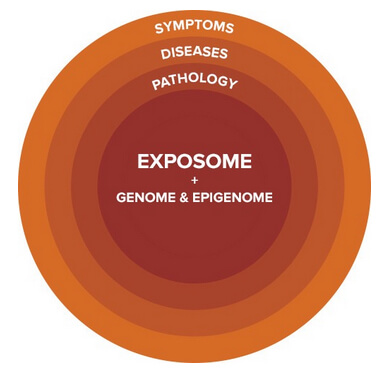
This
post was originally published on
this sitehttp://chriskresser.com/

We’re in the midst of the most serious epidemic of chronic disease humans have ever faced. Half of US adults have one or more chronic health conditions, and 25 percent have two or more. (1) 7 of the top 10 causes of death in 2010 were chronic diseases, and two of them—heart disease and cancer—together accounted for almost half of all deaths. (2)
While some of these problems (like heart disease) are fairly well-understood by conventional medicine, others are more mysterious. Conditions like Irritable Bowel Syndrome (IBS), chronic fatigue, fibromyalgia, and autoimmune disease together affect hundreds of millions of people around the world, but in most cases patients are told that the causes of their condition are unknown and simply prescribed drugs to manage the symptoms.
But is it really true that we don’t know what causes chronic illness? Certainly there are particulars related to each specific illness that we don’t yet understand. But I would argue that we do, in fact, have a solid grasp on the most important factors that contribute to virtually all chronic disease. This means that it is within our power now to prevent, and even reverse, many of these conditions.
The Functional Medicine Systems Model
As many of you know, I will be launching a functional medicine training program for clinicians later this year. (You can learn more about it here, and stay tuned for another announcement in the next few weeks!) In preparing for that program, I’ve created a “unified theory” of what causes disease that I call the Functional Medicine Systems Model. I’d like to share that with you here, and use it as a springboard for our discussion.

As the diagram illustrates, the interaction between an individual’s genome, epigenome, and exposome is at the core of what determines our health.
The genome is our complete set of DNA, containing all of the information needed to build and maintain the human organism.
The epigenome consists of chemicals that modify the genome in a way that tells it what to do, where to do it, and when to do it. These modifications do not change the underlying genes, but they can be passed on to future generations.
The exposome represents the sum total of all non-genetic exposures an individual experiences from the moment of their conception through the end of their life. It includes the food we eat, the water we drink, the air we breathe, the chemicals we’re exposed to, the social connections we have, and the environment we live in.
To use an analogy, the genome is like a piano; the epigenome is like the sheet music; and the exposome is what determines how the music is written and performed. The quality of the piano will certainly affect the sound that it produces. But the finest piano in the world will still sound terrible if the sheet music and performance are terrible. Likewise, a virtuoso pianist performing a Mozart piece will not be at her best playing a poor-quality piano.
In the same way, genetics do play an important role in human health and disease. However, we now know that the exposome (and its influence on the epigenome) is far more significant in most cases. In fact, it is responsible for >90% of human disease. That is why the exposome is at the core of the Functional Medicine Systems Model, and should always be the first thing addressed regardless of the patient’s complaint.
The modern diet, lifestyle, and environment affect the expression of our genes and lead to pathology, which in turn cause disease and symptoms in the patient.
But what are those pathologies?
The 8 core pathologies that underlie all chronic disease
I believe that virtually all diseases and symptoms that we experience are caused by the following 8 core pathologies:
- Gut dysfunction. Includes small intestine bacterial overgrowth (SIBO), infections (e.g. parasites, pathogenic bacteria, viruses), low stomach acid, bile, and enzyme production, intestinal permeability, and food intolerances.
- Nutrient imbalance. Includes deficiency of nutrients like B12, iron, folate, magnesium, zinc, EPA/DHA and fat-soluble vitamins (most common), and excess of nutrients like iron (less common).
- HPA axis dysregulation. Includes regulating the communication between the hypothalamus, pituitary, and adrenal glands, and balancing the production of hormones associated with those glands (e.g. DHEA, cortisol)
- Toxic burden. Includes exposure to chemicals (e.g. BPA, phthalates, etc.), heavy metals (e.g. mercury, arsenic), biotoxins (e.g. mold/mycotoxins, inflamm), or impaired detoxification capacity due to nutrient deficiency, GI issues, or other causes.
- Chronic infections. Includes “stealth” infections by tick-borne organisms (e.g. Borrelia, Babesia, Bartonella, Erlichia), intracellular bacteria (e.g. Mycoplamsa, Chlamydophila), viruses (e.g. HHV-6, HPV), and dental bacteria.
- Hormone imbalance. Includes hormones associated metabolism (e.g. insulin, leptin), thyroid, and gonads (e.g. estrogen, progesterone, testosterone).
- Immune dysregulation. Includes autoimmunity, underactive immune function, and chronic, systemic inflammation.
- Cellular dysfunction. Impaired methylation, energy production, and mitochondrial function, and oxidative damage.
These pathologies (and the exposome-genome-epigenome interactions that lead to them) are at the root of everything from obesity, to Hashimoto’s thyroiditis, to asthma, to autism spectrum disorders, to depression. The understanding that the same 8 core pathologies are at the root of most modern, chronic diseases has profound implications for how we should address these conditions.
In conventional medicine, the focus is often on diseases and the symptoms; it works “from the outside in”. For example, let’s say that you go to the doctor for your annual exam and your blood tests reveal that you have “high cholesterol”. The most likely outcome in this situation is that you’ll be prescribed a statin, and in some cases be told to exercise more and eat better. There is rarely any serious investigation into what caused the high cholesterol in the first place.
In functional medicine, however, we work “from the inside out”. We pay less attention to the symptoms, and more attention to the pathology that produces those symptoms. High cholesterol is a symptom, not a pathology. The pathologies that can lead to high cholesterol include poor thyroid function, intestinal permeability, disrupted gut microbiome, chronic viral or bacterial infections, insulin and leptin resistance, and nutrient imbalances—to name a few. If I find high cholesterol in a patient, we will examine all of these potential pathologies, and of course we will also look at how the individual’s genetics, diet, lifestyle, and other factors related to the exposome may be contributing to them. Once we have addressed all of the core pathologies, the cholesterol levels typically normalize on their own.
Whether the patient’s main complaint is infertility, fatigue, sinusitis, or skin problems, I will focus on these 8 core pathologies because I know (from both clinical experience and research) that they are the most likely underlying causes of their condition.
As you can see, this is a fundamentally different approach than what is typically done in the conventional setting. The downside is that it requires a lot more testing and investigation up front, which can be costly and time-consuming. The upside—which obliterates any of the downside considerations—is that it becomes possible to not only prevent, but even reverse many chronic disease conditions without the need for taking medication for the rest of your life.
Unfortunately, the functional medicine approach is not yet embraced within the conventional health care model. But I believe that is changing. The prestigious Cleveland Clinic just launched a Center for Functional Medicine, directed by functional medicine pioneer Dr. Mark Hyman. This is a big step toward mainstream acceptance of functional medicine, and the research the center is engaged in will almost certainly lead to even broader recognition.
I think health insurance companies will also see the benefits of functional medicine. They’ll recognize that spending a little more money up front to properly diagnose and treat the root of the problem will lead to enormous savings down the line.
These changes aren’t going to happen overnight, and we still have a lot of work to do. But the tide really is starting to turn!
If you’re a health care practitioner and you’re interested in training in this approach, sign up for the early interest email list to be notified when enrollment opens for my clinician training program. We’ll be making another announcement in July, and likely opening enrollment as early as August.
If you’re struggling with a chronic health problem and are interested in learning more about how this approach can help you, click here to learn more about how my team and I work with patients and set up an initial consultation.
Now I’d like to hear from you. Have you been able to resolve chronic health problems by addressing any of the core pathologies I listed above? Have you found success with a functional medicine and ancestral nutrition/lifestyle approach? How did that compare to what conventional medicine offered for your condition? Let us know in the comments section.
 This post was originally published on this site
This post was originally published on this site

 This
This 
 This
This 
 This
This 

 This
This 
 This
This 
 This
This 

 This
This 
 This
This 
 For now classes are 6pm and 640pm at 2840 Wildwood st in the Boise Cloggers studio.
Book your class NOW!
click this ==>
For now classes are 6pm and 640pm at 2840 Wildwood st in the Boise Cloggers studio.
Book your class NOW!
click this ==>








